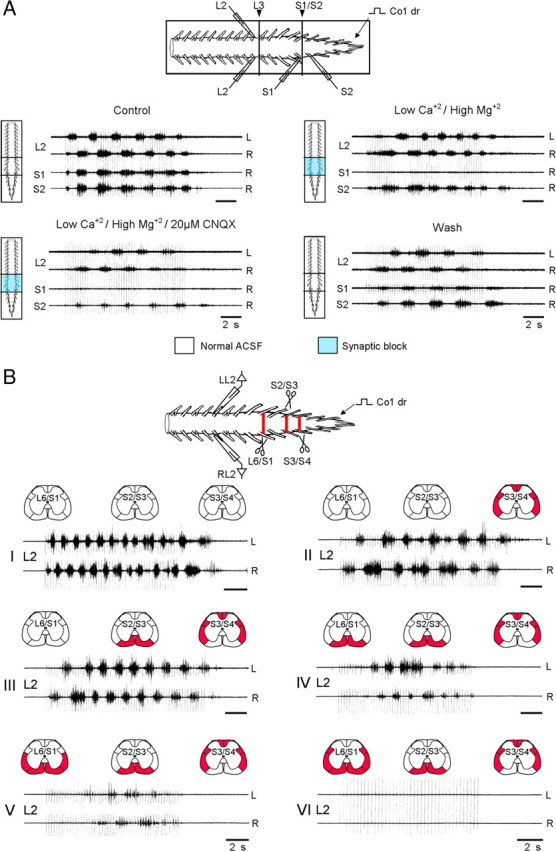Figure 5.

The involvement of sacral neurons with long and short ascending projections in the generation of the lumbar rhythm by SCA stimulation. A, The SCA-induced rhythm can be produced by activation of sacral neurons with long ascending projections. Schematic illustration of the experimental setting is shown on top. The preparation is mounted with ventral side up in an experimental bath that was divided into a rostral (T6 to caudal L2), middle (caudal L2 to rostral S2), and a caudal (rostral S2 to Co3) compartments, by Vaseline wall. The rhythm was produced by stimulation of the Co1 dorsal root and recordings were obtained from the left and right L2 ventral roots, and from the right S1 and S2 ventral roots. The rhythm was produced by stimulation of the Co1 dorsal root before (Control), after blocking the synaptic transmission from caudal L2 to rostral S2 by changing the bathing medium in the middle chamber from ACSF to low Ca+2/high Mg+2 ACSF (Low Ca+2/high Mg+2) and then adding 20 μm CNQX (Low Ca+2/High Mg+2/20 μm CNQX). Recordings were also obtained after alleviation of the block following 30 min wash (Wash). Stimulus trains: 50 pulse, 4 Hz, 2.4T. B, The lumbar CPGs can be activated by SCA stimulation when the direct contacts made by long-ascending axons from the sacral neurons are interrupted. The scheme on top shows the preparation and the experimental paradigm that was used in this series. The rhythm was produced by stimulation of the Co1 dorsal root and recorded from the left and right L2 ventral root. The preparation was surgically manipulated at three segmental levels S3/S4, S2/S3 and L6/S1 (red bars in the top, and red fills in the schematic cross sections above each set of traces). The rhythm is shown before (I), after cutting the VLF/LF, DLF and DF at the S3/S4 border and leaving the VF as the only intact funiculi (II), after bilateral interruption of the VF at the S2/S3 (III) and L6/S1 level (IV), extension of this latter lesion to the VLF/LF (V) and DLF (VI). Stimulus trains: 50 (I, III, V) and 60 (II, II) pulse at 4 Hz,1.75T; 40 pulse, 3 Hz at 2.5T (VI).
